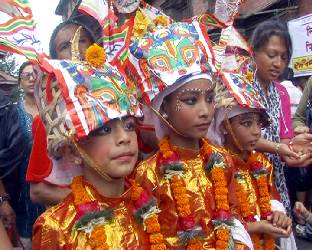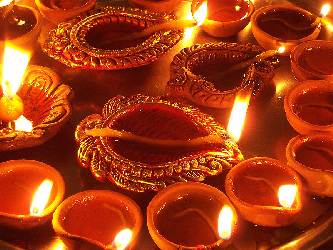FESTIVALS AND EVENTS IN NEPAL
Dashain
September–October
Dashain is a 15-day national and religious festival in Nepal. It is one of the longest festivals in the Nepalese annual calendar, celebrated by Nepalese hindu of all casts throughout the globe. Dashain is the biggest festival for the Hindus. This festival is known for its emphasis on the family gatherings, as well as on a renewal of community ties. People return from all parts of the world, as well as different parts of the country, to celebrate together. All government offices, educational institutions and other offices remain closed during the festival period.
Dashain commemorates the victories of the god and goddesses over the demons. The first nine days of Dashain symbolizes the battle which took place between the different manifestations of goddess Durga and the demon Mahishasura. The tenth day is the day when Durga finally defeated Mahishasura. Goddess Durga is worshipped throughout the country as divine mother goddess. Flying kites are a very important part of celebrating Dashain in the country. Colorful kites fill the days during the festival. Buying and wearing new clothes is also an important part of the festival. Almost all the shops in the country have festival offers and discounts. Different kinds of fairs and celebration events are also organized during the festival.
 Children preparing for Gaijatra festival in Kathmandu
Photograph by Krish Dulal
Gaijatra
August-September
Gaijatra, the festival of cows is celebrated in Nepal, mainly in Kathmandu valley by the Newar community. The festival commemorates the death of people during the year. During the festival, cows are marched in the streets and generally celebrated in the Nepalese month of Bhadra. The festival of cows is one of the most popular festivals of Nepal. The whole complex of Gaijatra festival has its roots in the ancient ages when people feared and worshiped Yamaraj, the god of death. According to the traditions since time immemorial, every family who has lost one relative during the past year must participate in a procession through the streets of Kathmandu leading a cow. In Hinduism, a cow is regarded as the most venerated among all the domestic animals. In the afternoon, nearly everyone takes part in another age-old tradition in which the participants dress up and wear masks.
Himalayan Blues Festival
November
Himalayan Blues Festival is an annual international music festival showcasing live performances followed by cultural events. The Himalayan Blues Festival has featured a diverse range of blues artist from around the globe and has helped introduce blues music in Nepal. The festival promotes various other genres including folk music. In 2010 the Blues Festival expanded to Mumbai, Bangalore and Delhi.
Tel: 9841297451, 9818097880. 9841360784, 9841674738
E-mail: info@himalayanblues.com
Tihar Festival
OctoberTihar is a five-day hindu festival celebrated in nepal which comes soon after Dashain. The festival is celebrated from Trayodashi of Kartik Krishna to Katrik Shukla Dwitiya every year and is of great importance. The name Tihar means the festival of lights. Celebrations include decorating homes with lights and candles, singing and dancing. The first day of the festival is called Kag Puja or Kag Parva - Worship of Crows. The second day is called "Kukur Puja" or "Khicha Puja" ("worship of the dogs"). On the morning of the third day is Gai Puja - the cow is sign of prosperity and wealth. The third and fourth day of Tihar is especially famous for Deusi and Bhailo, light and fireworks. The fifth and last day of Tihar is Bhai Tika, a day where sisters put "tika" on foreheads of brothers, to ensure long life.
 Tihar Festival
Maha Shivaratri
February-MarchMaha Shivratri is a Hindu festival celebrated every year in reverence of Lord Shiva. It is celebrated every year on the 13th night/14th day of the Maagha or Phalguna month of the Hindu calendar. The festival is principally celebrated by offerings of Bael or Bilva/Vilvam leaves to Lord Shiva, all-day fasting and an all-night-long vigil. In accordance with scriptural and discipleship traditions, penances are performed in order to gain boons in the practice of Yoga and meditation, in order to reach life's summum bonum steadily and swiftly. A week-long International Mandi Shivratri Fair held at Mandi in the Indian state of Himachal Pradesh every year is one of the major tourist attractions in the state. From the very early morning, Shiva temples are flocked by devotees, young and old, who come to perform the traditional Shivalinga worship (puja) and hence hope for favours from the god. Devotees bathe at sunrise, preferably in the Ganga.
Nepal Music Festival
September
The Nepal Music Festival invites the international community to join the Nepalese people in a celebration of hope transformation and peace - highlighting both international as well as Nepalese musicians, bands and performing art. The events involve top international guest speakers in the field of peace building and development. The Nepal Music Festival highlights contemporary and traditional Nepali Culture by bringing together a great variety of Nepalese musicians, artists and speakers to perform and share the festival stage with top international stars.
Address: Nepal Music Festival,
G.P.O Box: 8973,
N.P.C. 631,
Kathmandu, Nepal
E-mail: info@nepalmusicfestival.org
Chhechu
October
Chhechu is a ceremony of the Tamang communities in Nepal that takes place over the course of ten days. It contains sportive plays (tsema), exorcisms, and rituals. Chhechu takes place northwest of Kathmandu Valley of Nepal. There are eleven tsema performed, and three exorcisms. The whole community participates in a variety of ways. Throughout the ritual there are different exorcisms performed, intended to remove threats to the community. There are large scale performances in Mhanegang which villagers exorcise at regular intervals. Men with swords and women with weaving instruments dance around a large effigy constructed from bamboo. At dusk, the effigy is burned in a huge flash fire. On the last day of Chhechu, the Buddhist lamas distribute dough powder balls (Wang ro ro) to the principal headman, then his allies, their wives, then the villagers.
|